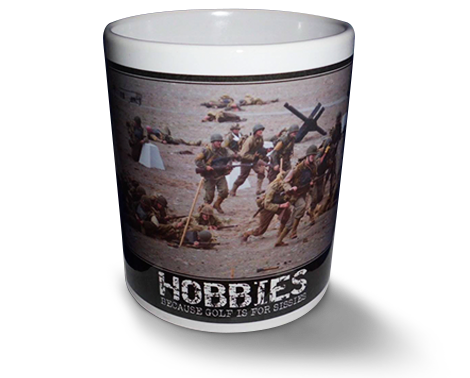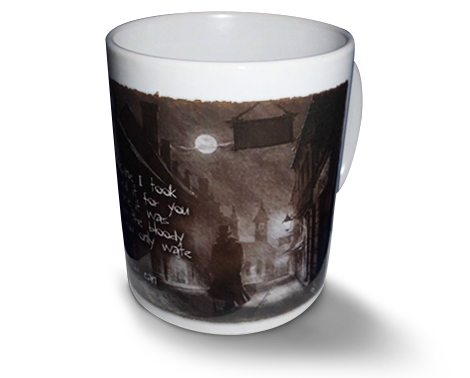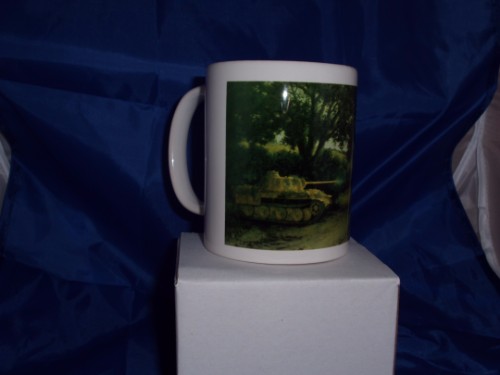Barkmann's corner Tank ace printed mug
11 oz dishwasher safe microwave safe printed mug
late 1943, Ernst Barkmann was promoted to the rank of SS-Unterscharfuhrer. In early 1944, the entire division was transferred to Bordeaux area in southern France for rest and refitting as a panzer division. Following the D-Day (June 6 of 1944), 2nd SS Panzer Division Das Reich was ordered to move northwards and was committed to battle.
In early July of 1944, Das Reich was moved to Saint Lo to halt the advance of the US Army's 9th and 30th Infantry Divisions and the 3rd Armored Division. On July 8th, Barkmann's Kompanie was a spearhead of Regiment's attack on the advancing American units. On this day, Ernst Barkmann knocked out his first Allied Sherman tank near St.Lo. On July 12th, he destroyed two more Shermans while disabling the third one. During that engagement Barkmann moved his camouflaged Panther to ambush position and awaited for more Allied armor, knocking out three Shermans. After that Ernst Barkmann's tank was hit by an anti-tank gun which caused fire. He decided to abandon his burning Panther and along with his crew he quickly put out the fire. After that engagement his Panther ended up in the workshop for repairs. After a day of rest, in morning of July 14th, Barkmann was ordered to recover four Panthers that had been cut off behind enemy lines. He succeeded in his task and added three more Shermans to his score. On the same day at noon, Ernst Barkmann was ordered by the Regimental Commander SS-Obersturmbannfuhrer Tychsen to recover wounded German soldiers from their American captors. Once again he succeeded and in the evening his own Panther was returned to him from the workshop. On July 26th, Barkmann's Panther suffered from engine problem and was sent to field workshop.When mechanics were working on it, field workshop was attacked by Allied fighter-bombers and Barkmann's Panther was hit in the engine compartment. By the dawn of July 27th, his Panther was repaired but he was cut off from the rest of the Kompanie and was on his way to rejoin it. On his way back, near the village of Le Lorey, Barkmann was stopped by the retreating German infantrymen who reported that Americans were closing in. Ernst Barkmann decided to send two of his men to verify that report. They soon returned with news of American column made up of some 15 Shermans and other vehicles approaching. Then Barkmann moved his tank up the road to the crossroad where he positioned his Panther in the surrounding oak trees, awaiting the enemy. When the American column approached, Ernst Barkmann opened fire, knocking out two leading tanks and then tanker truck.Two Shermans tried to go around burning wreckage that blocked the road and one of them was knocked out followed by the other one.In the response, Americans retreated and called up the tactical fighter support and Barkmann's Panther was damaged and some of the crew members were wounded. Using the element of suprise two Shermans attacked "wounded" Panther but were also knocked out.Barkmann and his crew repaired their Panther and knocked out single Sherman while leaving.His driver managed to moved their damaged Panther to the safety of nearby village of Neufbourg. During that brave engagement often called "Barkmann's Corner", Ernst Barkmann destroyed approximately nine Sherman tanks and many other various vehicles.
On July 28th, Barkmann reached Coutances and joined the rest of his Kompanie. During two day period, he destroyed fifteen Shermans and other vehicles. On July 30th, Americans surrounded Granville but Barkmann towing one more damaged Panther was able to break out. In order to destroy their disabled Panther their crew decided to set it on fire and soon by mistake both Panthers caught fire. Both crews were forced to make their way to the German lines 7 kilometers away on foot. Barkmann reached Avranches on August 5th, and was warmly welcome by his comrades who heard about his exploits. For his bravery and skills Ernst Barkmann was recommended for Knight's Cross and was accepted on August 27th and was awarded on September 5th.
SS-Oberscharfuhrer Barkmann continued his successful career and took part in the Ardennes Offensive in December of 1944, where on December 25th he was seriously wounded. During the Ardennes Offensive, Barkmann's Panther drove into the group of American tanks from the 2nd Armored Division. Quickly combat begun and outnumbered Barkmann managed to knock out few Sherman tanks. One Sherman rammed Barkmann's Panther but didn't cause much damage although both tanks got stuck and Panther's engine stall. After few minutes, Barkmann's mechanic managed to restart the engine and Panther retreated with blocked turret. Even with the damage, Barkmann knocked out Sherman that waspursuing him and retreated to safety although his Panther was beyond the point of repair.
In March of 1945, Barkmann was once again fighting with Soviets in the area of town of Stuhlweissenburg, where he knocked out four T-34s and brought the total score of the Das Reich Division for the war so far to 3000 enemy tanks destroyed. At the time Das Reich was exhausted by non-stop fighting and lack of replacement tanks. Barkmann's unit alone had only nine fully operational vehiclesfrom which three were soon lost to Soviet Josef Stalin tanks. The remaining six Panthers were ordered to link up with the remnants of the Panzer Regiment of the 1st SS Panzer Division Leibstandarte SS Adolf Hitler commanded by SS-Standartenfuhrer Jochen Peiper.By April of 1945, Barkmann saw action south of Vienna during the fighting in Austria. There his Panther was hit by a mistake by friendly soldiers and Barkmann along with his crew members was wounded. Later on his Panther was disabled in a huge bomb crater and was destroyed by its crew. Ernst Barkmann was able to reach British zone of operation where he was taken into captivity.
During his very successful career, Ernst Barkmann earned Knight's Cross for his bravery and skills along with the Panzer Assault Badge for 25 and 50 engagements with the enemy. He survived the war and lives in Kisdorf, Germany, where he was the long-time fire-chief and also major .







